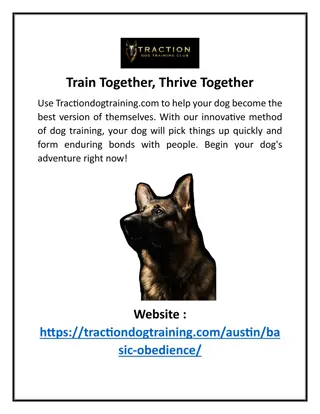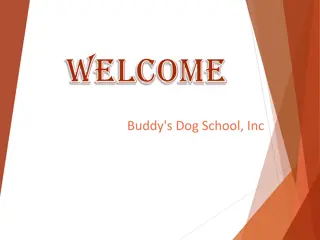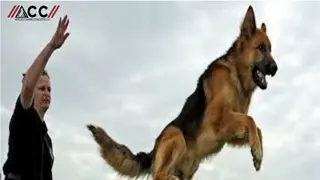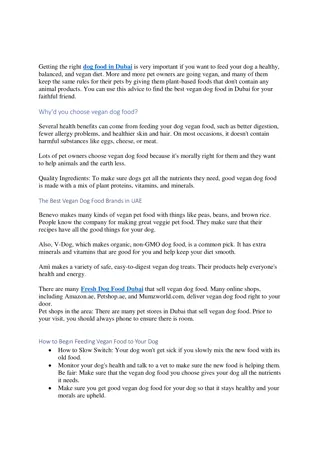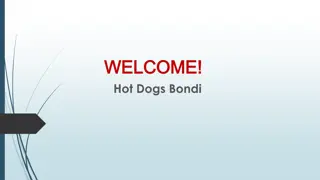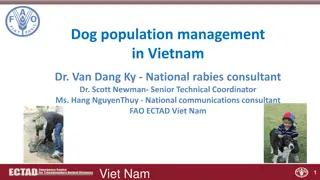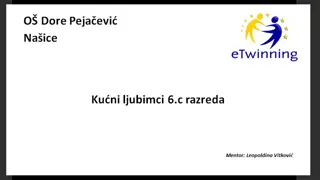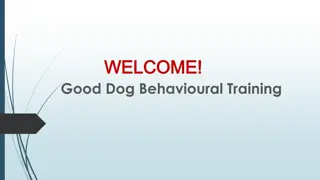Comprehensive Guide on Dog Care and Management
Learn about housing, feeding, and dimensions of kennels for dogs, along with tips on appropriate feeding that plays a crucial role in keeping dogs healthy and fit. Dr. R.R. K. Sinha provides valuable insights on the care and management of dogs, emphasizing the importance of suitable housing, feeding, and dietary considerations for different dog breeds.
Download Presentation

Please find below an Image/Link to download the presentation.
The content on the website is provided AS IS for your information and personal use only. It may not be sold, licensed, or shared on other websites without obtaining consent from the author.If you encounter any issues during the download, it is possible that the publisher has removed the file from their server.
You are allowed to download the files provided on this website for personal or commercial use, subject to the condition that they are used lawfully. All files are the property of their respective owners.
The content on the website is provided AS IS for your information and personal use only. It may not be sold, licensed, or shared on other websites without obtaining consent from the author.
E N D
Presentation Transcript
Care and Management of Dogs By: Dr. R R K Sinha
Housing of dogs 1. House of dog is known as Kennel. 2. For bedding a wooden bench or cloth piece of old bed sheet or gunny bag is adequate. But watch/guard or sporting or aggressive dogs should be kept at an isolated lace in dry, clean and comfortable kennel. 3. The ideal housing consists of a kennel within a small house with lean roof attached to boundary wall of bungalow. 4. Normally front portion is open providing good ventilation. Now a days a movable plastic kennel are available.
5. Depending on the need kennel can be temporary of wooden planks, galvanised iron, plastic or plywood sheets or asbestos sheet etc. 6. A retiring platform be arranged in each kennel with a height of 15 to 20 cm. 7. For breeding dogs open pens with fencing are ideal for exercise. The height of fence should be minimum 2.2 M. 8. The area for brood bitches should be twice the space provided to non-breeding bitches. 9. The floor should be spread with a thick layer of soft grass, straw, sand or ash which should be free from sharp objects.
Dimension of kennel (Size): Length Width Height Heavy Dogs 2.3 M 1.8 M 1.3 M Medium Dogs 1.6 M 1.2 M 1 M Small Dogs 1.2 M 0.80 M 0.70 M
Feeding of Dogs Appropriate and correct feeding plays a major role in keeping dogs vigorous, healthy and fit. The common food items can be grouped into following classes- 1. Non-Vegetarian Diet: - Meat Various kinds of meat, bones and bone scrapings, edible organs like heart, liver and kidney, cleaned and chopped viscera etc. Fish and fish meal. Poultry and poultry offal s like head, legs, viscera, eggs etc. Fat and edible fatty tissue.
2. Vegetarian Diet: - Milk and milk products- Whole milk, skimmed milk, dried milk powder, casein, curd, mattha, paneer etc. Cereals- Roti of wheat, jowar, bajra, barley, oat, corn and rice. Cereals By products- Wheat and maize germ meal, maize gluten, broken rice etc. Pulses- Gram, green and black gram, beans, soyabean, cowpea, pea etc. Vegetables & Fruits- Leafy vegetables, carrot, bean pods, banana, tomato, mango etc.
Feeding care: - Some precautions should be observed for feeding of dogs: Try to feed natural diet, like raw meat in small quantity with mixture of raw green vegetables. A large raw bone may be provided once in a week but small bones must be avoided because dog can swallow it leading to oesophageal or intestinal obstruction. Ready made dog chews may not be advisable as they lead to formation of urinary calculus. Desired substitute for meat protein are eggs, cheese, fish, chicken and rabbit meat.
Foods for pups should be semi solid or liquid. As raw eggs contain avidin an enzyme that is anti- vitaminic, they should be hard boiled for feeding. Use clean and separate bowls for feed and water. Drinking water is changed frequently to maintain its freshness. A fixed feeding schedule should be followed i.e. In afternoon and in the night. The dog should be allowed 30 minute to eat and remainder be thrown away. Liking to specific food should be avoided.
Feeding of damaged grains or spoiled food stuff should be strictly prohibited. Growing and breeding dogs should not be offered meat of hormonally implanted animals and chemically treated chickens. Nutrients required: Nutrients Approx. % (on DM basis) CP 18-20 Fat 4-5 Fibre 6-10 Ash 3-5 ME (Kcal/kg) of feed 3.5-4.5
The nutrients or energy needed for production i.e growth, work, pregnancy or lactation are naturally more then maintenance which can be approx. as- Status/ Type of Dog Energy required (ME, Kcal/Kg) Adult, Non-Productive 130 Advanced Pregnant Bitch 190 Lactating Bitch 450 Grower Pups 270 Adolescent Pups 200 Dogs meets more nutrient requirement with increase in consumption of food.
Factors influencing food intake: 1. Dog Size: - Small sized breeds up to 9 kg requires around 60% less calories/kg Body weight than dogs of 10 to 35 kg. Large breeds weighing more than 35kg needs 30% lesser calories /kg body weight. 2. Atmospheric temperature: - Dogs which remain in cold weather need additional food. About 30% more calories from December to February than June to August. On an average they requires about 7.5% more calories for each 10 C drop in temperature.
3. Body Metabolism: - Two dogs of equal size, age and activity may need different metabolic rates. 3. Suspended reproductive activity: - Castrated or Spaying make most dogs docile leading to consume lesser calories.
Category feeding of dogs: - Frequency and quantity of food varies according to category depending on age. 1. Pre-weaning category (upto 7/8 weeks): - Prior to weaning most of the puppies are fed mixture of milk, baby cereals, vitamins, eggs, meat or similar ingredients. 2. First category(Weaning to 12 weeks of age): - Around four feeding quantities depending on size and breed are offered. The smaller breeds can be fed total quantity of 115g and large breeds 450 to 500g.water should be given ad labium. daily with different
3. Second Category (12 to 18 weeks): - The amount of feed should be gradually increased as per the growth of dog. The milk should be cut down to half for a month then completely stopped. The no. Of feeding be reduced to 3 per day. The total quantity may be raised to 230gm and 900gm for small & large breeds respectively. 4. Third Category (Over 18 weeks): - This is an adult dog which can be fed twice a day. An average size dog need daily minimum 450gm and large size 1.40kg of food. For correct feeding dog should be fed daily 5% of its body weight.
Commercial foods: Pet foods have gone commercial and many brands with different types of pet foods are available in the market, which are ready to fed directly. Following are some common commercial pet foods available in the market- 1. Canned dog food: - Most of the canned foods contains excellent quantities of vitamin and minerals but have high moisture % (upto 85%) hence needed to feed double the quantity to meet protein requirement.
2. Soft moist dog foods: - They have ideal % of protein, moisture with good amount Vitamins and minerals. 3. Dry dog foods: - These foods have lowest % of moisture and highest amount of protein. Their energy content is also high and dogs are well satisfied after eating these foods.
Nutrient composition of various types of commercial dog foods Nutrients Types of food Canned food Soft Moist food Dry food Water (Moisture %) 85 30 10-12 Protein % 10-15 20-25 22-27 Fat % 5-15 5-10 8-10 CHO % 10-15 30-35 40-45 Energy (Kcal/kg) 850-2100 2600-2950 3000-4000 Palatability Good Moderate Moderate Storage Easy Easy Difficult Cost High Moderate Low
Food supplementation and facts: - When a complete, balanced food is offered to normal pet of any breed, there is no need of any supplementation in the form of vitamins, minerals or other additives. Supplementation need: - Occasionally supplementation may be needed to correct a particular deficiency. Supplementation may sometimes required for hard working dogs.
Common supplementation and risk: - 1. Raw eggs: Are excellent source of protein, but often and repeated feeding of raw eggs to pet leads to deficiency of vitamin biotin because it contains Avidin, which destroys biotin. Dermititis, loss of hairs and poor growth are symptoms of biotin deficiency. 2. Cod liver/Wheat germ oil: These are good source of vitamin D & E. Addition of excessive oil for longer duration will supply more vitamin D which results into soft tissue calcification and skeletal disorder.
3. Supplemental Minerals: It is thought that ca and other minerals are more required in pregnancy and growing puppies. These minerals are very well obtained through increased intake of good quality of complete and balanced diet. 4. Supplemental vitamin: Supplementation of excess vitamin can lead toxicity. This is commonly noticed in case of vitamin A which leads to poor growth and abnormal eye conditions and also affect reproduction performance.
5. Meat/Meat by products: Meat or meat by products alone in higher quantities cannot form balanced or complete diet unless they are supported with certain vitamins, minerals an other nutrients. Meat supplementation is only recommended when a high dense food and increased food intake cannot maintain good quality body condition under stress. 6. Milk: In spite of individual variation usually adult dog and cats are not able to digest and utilize large quantity of milk, it is because their is absence of adequate amount of lactose enzyme in the gut, so the lactose in the milk can lead to diarrhoea.
Pregnancy and Whelping The duration between successful mating and whelping is known as pregnancy or gestation. The average gestation period in bitches is around 63 days ranging from 60 to 70 days. False or Pseudo pregnancy: The signs of pregnancy at an appropriate time after oestrus cycle in unmatched bitch, usually in luteal phase is known as Pseudo pregnancy. This is due to hormonal imbalance. The condition show enlargement of abdomen, swelling of mammary glands, mucoid brownish discharge from vulva. The condition is observed in around 5 to 40% bitches among various breeds.
Detection of pregnancy: After 4 to 5 weeks of mating, clinical signs of pregnancy starts appearing. The common clinical signs are deprived appetite, nausea and vomiting tendency. A progressive abdominal enlargement is noticed after 5 weeks. In case of large litters this enlargement can be noticed from 4 weeks. It is difficult to palpate foetuses upto 6 to 7 weeks due to amniotic fluid around them. During last 2 weeks they can be palpated along with their movement, pregnancy can be confirmed by ultrasonic scanning.
Care during pregnancy: Pregnancy duration can be divided into 3 stages- 1. The stage extends upto 3 weeks post mating. 2. Second stage lasts from 3rd upto 4 and half weeks of post mating. In the initial part of which the implantation of fertilized ovum takes place. 3. The third or terminal stage begins around 5th weeks from mating and is crucial period for active foetus growth. So, providing balanced nutrition with special attention is given to protein/energy and vitamin required like Vit. A and Vit. D along with minerals like Ca and P.
Evaluation of bowel is an important aspect especially during last few weeks of pregnancy. Ample quantity of clean drinking water is prime requirement during this period. For maintaining the tone of internal organs and muscles moderate exercise is must during all stages of pregnancy. Before mating, the bitches should be treated for eradication of worms.
Whelping (Parturition) The art of giving birth to pups is known as whelping in bitches. The primary indications are nesting behaviour. Around 25 to 30 hrs before whelping bitches also exhibit restlessness, anorexia, look at the flanks and shivers due to lowering down of temperature. The act commences with relaxation of pelvic ligament, dilation of genital passage and uterine contractions at an interval of every 7 to 8 minutes. After this cervix gets opened with the influence of hormones and pressure of uterus.
This is followed by forceful contraction of uterine muscles to expel foetuses. The foetuses move towards cervix and first amniotic fluid bag appears out of vulva. Following this head of foetus and then foetus is expelled out. Normally first pup is delivered little late i.e. Within 35 to 50 minute then subsequent pups may take 5 to 15 minute for each pup to come out.
Whelping care: The prime need of whelping is some form of bed or box. Lined basket is good for small breeds and wooden box is good for large breeds. Bitch should be provided with nesting material to satisfy her natural instinct of building nest. For puppies a thick mat covered with a piece of clean blanket be provided as bed for first 2 weeks after birth. Unnecessary disturbance should be avoided. If whelping doesn t start within 2 hours of vigorous labour then veterinary assistance should be given.
New born puppies should be left with their mother for licking and turning them b her for respiration and circulation stimulation. During whelping and for 2-3 days, a movable guard rail should be fitted to 3 sides of box at a height of 7-8 cm from the floor of box to prevent puppies being crushed by careless bitch.
Post whelping care of bitch: After whelping genital organs take sometime to recover to normal. For 1 or 2 weeks after whelping, blood stained discharge continues consisting of blood clots. This discharge usually stops after 10-15 days. The temperature which rises around 1-2 C after whelping should come to normal within 48 hours.
If the temperature doesnt return to normal and discharge emits off odour or showing pus then it should be treated with suitable antibiotics. For initial few days post whelping her food should be milk & milk products, Commercial cereal preparation with addition of egg yolk. Meat and fish can be given after 4-5 days.
Composition of cow, goat and bitch milk: Nutrients Cow Milk Goat Milk Bitch Milk Water 87.5 85.7 75.0 Protein 3.5 4.3 11.0 Fat 3.5 4.8 10.0 sugar 4.8 4.5 3.3 Ash 0.7 0.7 0.7
Fostering: In case of large litter size (more than 6 to 7 puppies) or death of mother or negligence of puppies, by their mother, puppies can be reared with foster mother which is called fostering. Usually, a newly whelped bitch which has smaller size litter and of suitable breed with good health, temperament and free from parasites is chosen for this purpose. To introduce these foreign pups in the family of foster mother is tough. It can be done by following methods-
The difference between age of puppies of foster mother and foreign pups should not be more than 2 to 3 days. While introducing these new pups, she should be taken away for 1 to 2 hours and these foreigners be well mixed with her own litter to acquire their scent. Few drops of milk extract if spread on coat of new pups may help the bitch to lick them and accept them. In case of fostering for large litters, the best puppies should be left with their original mother and only inferiors can be shifted to foster mother.
Hand rearing: This method is only adopted in situation of complete stoppage of milk production by bitch or ill health or death. Warmth is the prime need in this process. Rubber bags/bottles kept in blanket under the bedding are suitable for first 2 to 3 weeks. Feeding should be at 2 hours interval during day and night for 1st week. For milk feeding temperature should be around 37.7 C. At the age of 4 weeks feeding of meat and cooked eggs can be introduced by reducing milk feeding. From 5 to 6 weeks age puppies can be fed at every 3 hours interval.
Post weaning management of pups: It is better to wean the puppies at the age of 7to 8 weeks. The feeding can be still done at every 3 hours which can be continued upto 10 weeks. From the age of 10-12 weeks ordinary milk is sufficient. Meat in ample quantity with various items like fruits, green vegetables can also be added to food. At this stage feeding can be done to 4 times daily with ad-lib milk. Between 16 to 20 weeks, milk can be cut down to 3times but quantity should be adequate.
Other managemental operations of puppy rearing: 1. Elimination of unwanted puppies: In the interest of breed, the kindness for rearing of weak, malformed puppies is not fair, hence destroying them is the only method for elimination. The ideal method is to submerge them completely under warm water immediately after birth until stoppage of breath. The other method is to administer lethal dose of Nembutal inter abdominally for older puppies.
Clipping of dew claws: Dew claws are rudimentary thumbs present above digits on fore leg and sometimes on the hind leg also. If they are not clipped, they become long and sharp and causing trouble for nails. Docking: This is usually carried out during first week of life. A specific length of tail should be kept depending on breed. Handling of dogs: Dogs are required to be handled for day to day managemental operations, clinical examination, medication transport etc. A proper restraint is prime need of safe and stress free handling. and vaccination,
Nail clipping: Due to young age and growth phase, nails of puppies grow fast and from first week onwards a pair of nails scissors should trim them regularly at few days interval. If this is not practiced, nails become very long and sharp with which puppies scratch each other and bitch also. Teeth-cutting: Dogs have two sets of teeth. The first deciduous or milk teeth which starts erupting at around 3 weeks and usually cut at 5 to 6 weeks of age. These are 28 in number and softer and sharp than permanent teeth. The permanent teeth starts erupting at the age of 12 to 15 weeks in most of medium and large sized breeds whereas little later in toy breeds. The total number of permanent teeth is 42 to 44.
Vaccination Sl. No. Disease Type of vaccine Vaccination schedule Primary Booster (weeks) (weeks) Route/ Dose Repetition 1. Canine Distemper Modified Live 6-8 4 weeks later 1ml s/c or I/m Annually Virus 2. Canine Parvo Viral gastroenteritis Live 6-8 4 weeks later 1ml s/c or I/m Annually Attenuated 3. Infectious Canine Hepatitis Live 6-8 4 weeks later 1ml s/c or I/m Annually Attenuated 4. Parainfluenza Virus Live 6-8 4 weeks later 1ml s/c or I/m Annually Attenuated 5. Leptospirosis Killed bacteria 6-8 4 weeks later 1ml s/c or I/m Annually 6. Rabies Inactivated 12 and above - 1ml s/c or I/m Annually
Vices in dogs: 1. Aggressiveness: Some dogs can be aggressive even to owners and may bite. many a times such tendency is developed by pampering and can be reduced by proper training. some times it is hereditary. 2. Unwanted barking and howling: This is usually developed due to continuous chaining and confinement. Good exercise with free movement can control this vice. 3. Thieving: Few dogs thieve materials such as milk, bread etc, in absence of owner. Supply of adequate food and training can overcome this vice.
4. Cannibalism: Eating of own puppies, mostly observed in primipara bitches. Separation of puppies immediately after whelping and watch to prevent vice is the remedy. 5. Coprophagia: Eating of own faeces is serious vice and once the taste is developed it is difficult to get rid off. Close watch and immediate removal of faeces and training are corrective measures



